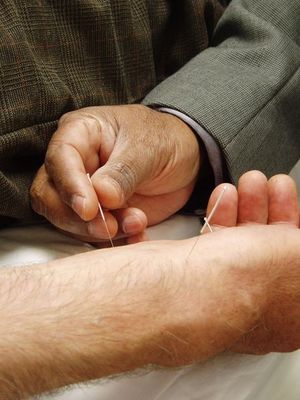Endometriosis is a painful condition that affects girls and women of reproductive age. Currently there is no cure for endometriosis, and some of the most common treatments for the disease include painkillers and invasive procedures, such as laparoscopies, laparotomies, and hysterectomies.
More and more, women are turning to complementary medicine to try to decrease and manage the pain of endometriosis. One of the most popular complementary therapies utilized for the treatment of endometriosis is acupuncture.
What is Endometriosis?
Endometriosis is a disease of the female reproductive organs and pelvic area. It affects approximately 5.5 million girls and women in the U.S., and approximately 70 million worldwide. The most common symptom of endometriosis is pain in the pelvic area. For many women, this pain can be severe and debilitating. This pain occurs most often, and is the most relentless, before, during and after a woman’s menstrual cycle. Other symptoms of endometriosis include pain during ovulation, heavy or irregular menstrual periods, pain during and after sexual intercourse, pain during urination and bowel movements, low back pain, diarrhea and constipation, abdominal bloating, bowel obstructions, digestive problems, fatigue, and, in 30-40% if women with endometriosis, infertility. (Endometriosis.org)
What is Acupuncture?
One of the most commonly utilized forms of complementary medicine practiced in the U.S., acupuncture is a form of Traditional Chinese Medicine (TCM) that was developed in China over 3,000 years ago (and may date back as many as 5,000 years). The word acupuncture is made up of the roots “acus” meaning needle, and “puncture” meaning the piercing of the skin. Acupuncture literally translates to “puncture with needles.” By placing hair-fine needles into the skin at strategic points in the body known as “acupuncture points,” acupuncture is believed to promote healing, alleviate pain, restore energy, bolster the immune system, and generally encourage good health.
Acupuncture for Endometriosis
There are several commonly held theories about the cause of endometriosis, but currently, there is no clear medical understanding of what causes the disease. Also, there is no cure. In an effort to avoid reliance on narcotic pain medications and invasive surgical procedures, more and more endometriosis patients have been turning to acupuncture to help to alleviate the pain associated with the condition.
The focus of acupuncture treatment is the “qi” (pronounced “chee”) or the life energy of the body. It is believed that when the qi is out of balance, blocked, or stagnated, illness and pain result. Pain and illness can also cause the imbalance of the qi, as the chicken and the egg are interconnected, and one will always come first. The process of acupuncture, of the placing of needles into the acupuncture points corresponding with the location of the disharmony of the qi will restore the qi to balance and allow it to flow freely again, thereby alleviating the symptomatic problems.
Acupuncture can be particularly effective in the treatment of conditions like endometriosis, where causes and cures for the disorders are unknown. Acupuncture treats the symptoms the body is experiencing. The acupuncturist will take a history of the patient and her experience with endometriosis, and will determine a course of treatment specific to the patient.
In patients with endometriosis, the goals of acupuncture are to ease the symptoms caused by the condition by improving circulation of the blood, stabilizing your hormones, and improving the flow of qi in the body. Of added benefit, acupuncture stimulates the release of endorphins, the body’s natural painkiller, into the body, promoting feelings of health and alleviating pain.
What Does a Patient Experience During Acupuncture?
The acupuncturist will examine the patient first and take a comprehensive medical history. The details of the patient’s diagnosis and experience with endometriosis will be discussed. During the examination, some of the techniques used to evaluate the system are unique to acupuncture, and may seem odd to the patient. For instance, the acupuncturist will take the patient’s pulse, but in doing so, he or she will generally take it three times, and will alternate which fingers he or she is using to read the pulse. The patient’s tongue will also be examined, as deficiencies of the vital organs and depletions of qi are evident in the shape, texture, and color of the tongue.
After the examination, the patient will lie down on a massage table, either prone or supine, and the acupuncturist will place some needles in the body. These needles are very fine, (the average diameter of an acupuncture needle is 0.015 inch), and are generally painless. At most, some patients report what feels like a “zap” or a “bug bite” type feeling when the needle is inserted, which quickly resolves. This usually occurs if there is a high concentration of qi blocked around a particular point.
The number and location of the needle sites will vary patient-to-patient, and often visit-to-visit, depending on the needs of the patient at that point. Needles may be placed in the part of the body that is causing the patient trouble, or they may be inserted into locations nowhere near the source of the pain or problem.
Once the needles are in place, the patient will lie quietly in a dim room, generally with soft, non-lyrical, music playing, for anywhere from ten to forty-five minutes. The time varies, depending on the needs of the particular patient.
Is Acupuncture Safe?
There are few negative side effects to the use of acupuncture. The most common adverse affects include bruising or slight swelling around the needle site, or soreness. Occasionally, due the relaxing nature of the procedure and the calming affect of acupuncture on the energy of the body, patients may report a slightly sedated feeling, and in rare occasions, experience a vasovagal (wooziness, fainting) episode. These responses are generally mild and resolve quickly. There have been very few cases of serious injury due to acupuncture treatment, however, as with all medical therapies, patients should discuss possible side effects of acupuncture before beginning treatment.
Because acupuncture employs the use if needles, it is also important to ensure that the practitioner is maintaining appropriate safety precautions regarding the sterilization of the needles. Most acupuncturists today use disposable needles that are discarded immediately after use in one patient. If the acupuncturist is not using disposable needles, it is appropriate to inquire about their sterilization procedures.
Will Acupuncture Work for You?
Unfortunately, as with Western medical treatments, no one therapy works for all people. To date, no one really understands how the mechanism of acupuncture works, nor do they know why it is more successful for some than for others.
Because the cause of endometriosis us currently unknown, and an exact and constant picture of the symptoms a woman with endometriosis will experience is impossible to paint, therapies like acupuncture can often be particularly helpful in the treatment of the condition. In the early stages of endometriosis, or in less severe cases, it is common for women with the condition to be misdiagnosed, hampering the efforts of Western therapies to appropriately manage the symptoms caused by the disease. Acupuncture treats the symptoms of disease, and can therefore be very successful even when the exact nature of the problem is not understood.
There is no magic bullet for the treatment or cure of endometriosis. Regardless of any assistance provided by acupuncture, for patients suffering with endometriosis, continued care by the patient’s other health care provider(s) is warranted. Acupuncture can help the patient to manage the pain associated with endometriosis, and may provide some relief which will help the patient to gain greater benefit from the therapies available to her. Nonetheless, it is my belief that acupuncture should be utilized in conjuncture with conventional western treatment, as an adjunct treatment, and not in place of it. Taking advantage of everything the medical knowledge of both hemispheres has to offer is a great way to ensure the most effective treatment for this painful, complicated condition.







